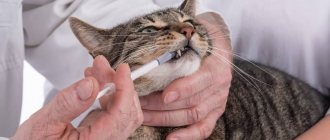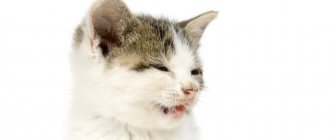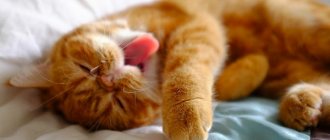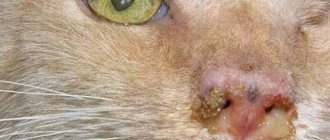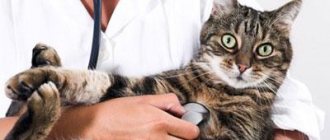03/06/2019 Drozd Nikolaevich Animals Sometimes small and adult pets have problems with their eyes. For example, a cat develops excessive lacrimation, the eyelids stick together and turn slightly red, and purulent discharge begins. The animal often covers its eyes from the light with its paw.
The reasons for this condition are different: trauma, breed characteristics, foreign objects, infection, virus, helminths, allergic reaction, age, entropion. Even a common cold or the consequences of a draft provoke the disease. But not everyone knows how to wash a cat’s eyes at home.
Causes of discharge from a kitten's eyes
It is worth clearly knowing all the reasons when eye rinsing is required in a small animal. The first rule in this matter is that you cannot touch the mucous membrane without a real violation. Preventive treatments are never carried out on the organs of vision, as they can cause unnecessary irritation, decreased vision and can cause infections if hygiene rules are not followed.
Cat's eyes: structure, diagram
You can wash your kitten's eyes only after external changes appear that indicate the presence of pathology or foreign objects getting into the cornea. Treating the visual organs of cats is allowed if they have the following diseases and problems:
- the need to cleanse the eye to instill antibiotics in the presence of infection;
- injuries of the cornea and eyeball;
Corneal ulcer in a cat
- regular treatment of organs due to the structural features of the nasolacrimal duct;
- contact with the mucous membrane of foreign objects, including dust;
- lacrimation and mucus formation associated with exposure to an allergen; rinsing in this case reduces the concentration of the harmful substance;
- infection with worms, while the animal never experiences a high temperature;
- conjunctivitis, blepharitis and other infectious disorders that can cause accumulation of pus and mucus.
Attention! Persian cats, Scottish fold cats, and British shorthairs are distinguished by the special structure of the nasolacrimal duct. Because of this, the animal constantly produces a large amount of tears and mucus, which can clog the eyes and cause irritation. To prevent this, regular washing is carried out every 5-10 days.
Kitten with sore eyes
Features of the procedure for adult cats
Usually cats are reluctant to allow any medical manipulations to be performed on them. This makes eye rinsing difficult to do alone. It is better to do this with an assistant who will hold the animal.
- Prepare equipment: cotton pads, tissue napkins, gauze or bandage, syringes without a needle for 5 or 10 cubes.
- Wrap the animal in a towel or soft cloth to secure it.
- Moisten a cloth with warm medicinal solution and squeeze onto the affected eye.
- Wait for the crusts to soften, and then remove them with a cotton pad using movements from the outer corners of the eyes to the inner ones.
- When eyelashes stick together with pus, move the napkin from your nose to your ears to open your eyes. In this case, cotton pads need to be changed as they become dirty.
- Gently pour the solution onto the cornea of the cleaned eye using a syringe.
- Remove excess solution by dabbing the eye with a dry cloth or cotton swab wrapped in a bandage. During the procedure, try not to touch the eyeball with gauze or a swab.
Attention! Before washing your cat's eyes, you should not wipe them with dry cotton wool, as this will lead to even greater irritation of the eye organs.
Symptoms and possible eye diseases in kittens
The need to use eye wash solutions in a pet is determined by the nature of the signs of the disorder and the nature of the discharge from the mucous membrane.
- The appearance of thick mucus, in which pus is noticeable, is most often associated with fungal infection and infections. The mucus has an unpleasant odor, yellow color and often leads to complete sticking of the eyelids. Cats often develop a fever, weakness, and loss of appetite.
- When the mucous membrane or cornea is injured and the allergic reaction spreads, the animal suffers due to the release of watery and clear fluid. At the same time, you can observe redness of the eyes, itching, and constant blinking.
- If tears are constantly released from the eyes, which after drying take on a dark or crusty appearance, we can talk about dirt and dust getting into the mucous membrane. With this disorder, eye hyperemia may also occur.
Conjunctivitis in a cat
When does rinsing become necessary?
Usually, owners begin to worry in two cases: when a pet produces an excessive amount of tears from its eyes or when one or both eyes fester.
Based on some factors, the reason for this deviation can be determined.
- Clear or slightly yellowish tears can be caused by soil, dust, or other similar irritants getting into the eyes. The second reason is the common cold. Pets, like people, can catch a cold in a draft.
- If your cat's eyes turn sour, you need to take him to the veterinarian. You should also pay attention to whether there is slight redness of the affected area. If the answer is yes, the pet may have damaged the cornea of the eye. And if your pet constantly covers its eyes with its paw, an infectious pathology is quite possible. In any case, a visit to the veterinarian cannot be postponed.
It is worth noting that even people whose pets are not sick need to think about how to wash a cat’s eyes. Such procedures are a mandatory element of animal care.
Traditional preparations for washing the eyes
If for some reason the kitten’s owner does not want to use medical solutions for rinsing or they simply are not at hand, but immediate assistance is required, unconventional drugs can be used. It is important to follow the dosages of the components used and not exceed the recommended number of medications.
Table 1. Traditional methods for washing the eyes of kittens.
| Ingredient | Cooking method | Dosage | A course of treatment |
| pharmaceutical camomile |
|
| Until symptoms are completely cured |
| Manganese crystals |
|
| No more than 3-5 days |
| Calendula |
|
| Until symptoms are completely suppressed |
| Series |
|
| Until symptoms are completely eliminated |
Attention! Manganese solution should be used with great caution in treatment. It is necessary to achieve complete dissolution of the crystals so that they do not burn the cornea and adjacent skin.
Ready-made calendula solution for washing
When is the procedure required?
Such manipulations may be required if there is any inflammation. It can be triggered by injury, entry of a foreign object (small insect, pollen or speck), the development of conjunctivitis, viral infections, allergic manifestations, entropion of the eyelid or infection with worms.
You can determine what exactly caused the inflammatory process in a cat by the nature of the discharge. Thick and yellowish discharge, the presence of pus and sticking of the eyelids indicate the appearance of an infectious, bacterial or fungal disease. If the discharge is clear and watery, the animal rubs its eyes with its paws, there is an injury or allergy. Transparent drops dried in the corners are a sign of dirt or dust.
Medicinal eye washes
Diamond Eyes Drops
An effective medication for suppressing many visual disorders. The drops contain taurine and succinic acid. This combination produces a powerful antibacterial and decongestant result, relieves severe and mild inflammatory processes. Used to eliminate infectious lesions, dissolve crusts in the corner of the eyes, treat acute and chronic conjunctivitis, and are suitable for the complex treatment of allergic reactions.
When using Diamond Drops, the following dosages are observed:
- to wash the exudate and treat mild chronic conjunctivitis, it is enough to use 1 drop of solution every 5-10 days; the product can be used up to three times a day;
- if the kitten’s condition requires taking medication daily, you cannot use it for more than 45 days, after each course there is a break of 10 days;
- with double treatment, eye drops cannot be instilled every day for more than 20 days, the break after each course is one week;
- with three treatments every day, eye drops cannot be used for more than two weeks; after each course, a break of at least five days is required;
- If your pet is diagnosed with increased tear secretion, redness, foreign body penetration and injury, it is recommended to prescribe drops three times a day for no more than two weeks.
The drops are well tolerated by kittens and, if the dosage is observed, do not provoke any negative reactions.
Veterinary drug Diamond eyes for prevention and treatment
Saline solution at a concentration of 0.9% of the active substance
It must be purchased only in pharmacies; it is very difficult to independently bring the concentrate to the required dose of 0.9%. If this amount of active substance is exceeded, there is a high risk of redness and burns of the eyeball. The solution is used up to three times a day for external treatment of the eye. If necessary, it can be used dropwise in one dose no more than twice a day. Duration of use – up to two weeks.
Ophthal
Drops are used to eliminate irritation due to sand, dust, and the release of tears during an allergic reaction. Use the medication for no more than three days at a concentration of 0.5 mg/ml of the active substance. For rinsing and treatment, it is enough to instill one drop of Ophthal no more than twice a day.
Ophthal drops for treating and washing the eyes of kittens
Dewdrop
Hygienic lotion based on chamomile and sage. Used to remove dust, dirt, accumulated exudate, and additionally cares for the skin. Well tolerated by kittens. To eliminate the problem, you need to moisten a sterile swab with lotion and soften the accumulated crusts with it. Once they are removed, you should wipe the eye again. Treatment is carried out once a day, if necessary, a repeated procedure is allowed. Between uses of Rosinka lotion, a 5-10 day break is required for regular care.
Dewdrop
Anandin
Drops prescribed in the presence of increased lacrimation due to allergic rhinitis or conjunctivitis. Taking into account the severity of the kitten’s condition, 1-2 drops of the drug are instilled into the lower eyelid no more than twice a day. Sometimes a single dose can be increased to 2-3 drops, but usually this dosage is used only for adults. The recommended course of therapy is no more than two weeks.
Read more about the use of the drug "Anandin" for cats, the characteristics of the drug, and side effects here.
How to properly care
The most common method is washing. They use various lotions, decoctions and infusions of medicinal herbs. If you have to take care of a cat’s sore eyes, your veterinarian will prescribe certain medications. Instillation of drops and application of medicinal gels and ointments are also often used.
Rinsing is carried out as follows: a small amount of the lotion used is applied to a clean swab (gauze, cotton-gauze, you can also use a napkin), but so as to moisten the fabric abundantly. Confidently holding a wet swab in your right hand (for left-handed people - in your left hand), hold the cat's head from the side with your other hand. With a precise, gentle movement, wipe the eyelids, removing dirt. You should move in one direction along the growth of the fur, that is, from the inner edge to the outer corner of the eye. The inner corner is wiped towards the nose. The same is done with the second eye.
If there are problems with the eyes, and the doctor has prescribed abundant washing, irrigation of the mucous membranes of the eye, you need to draw the required amount of the prescribed medicine into a syringe without a needle, pull back the eyelid, and, pointing the nozzle of the syringe at the mucous membranes, irrigate the affected areas under light pressure. To do this, the piston should be pressed in slowly and evenly. If you cannot control the pressure, it would be more rational to use a pipette, from which you carefully drop the medicine into the eye. Then gently wipe the leaked excess from the muzzle with a swab.
Be sure to wash your hands before rinsing or putting drops in your cat's eyes. It is also worth remembering that a separate disposable swab is used for each eye and, if necessary, changed several times during the procedure.
If your cat has been prescribed eye drops, all crusts and other contaminants must be removed before instillation. The eyelids are thoroughly wiped and the eyes are washed if necessary. If the stains are abundant and dried, they need to be soaked and then removed. Drops are instilled into the inner corner, onto the mucous membrane of the eye. To do this, hold the cat securely, pull back the lower eyelid in the same way as during examination, directing the spout of the bottle or pipette (depending on how the medicine is stored) to the desired place, lightly press on the body of the bottle, and a drop will be released. Having counted out the required amount, do the same with the second eye.
Ointments and gels are placed in the prepared eye, also behind the lower eyelid. You can squeeze it onto your finger or onto a glass rod, then apply it to your eye. This makes it more convenient and easier to dose the amount of medicine, as well as control the pressure and direction of putting the medicine. There is no need to squeeze the ointment into the eye directly from the tube. You can easily injure this delicate organ of vision, as well as disrupt the purity of the remaining medicine in the package.
After applying the ointment or gel, you need to massage the closed eye a little in a circular motion. This helps distribute the medication evenly and remove excess.
Eye lotion
Solutions for rinsing for inflammations of an infectious nature
Such medications should be used for bacterial conjunctivitis, blepharitis, and purulent eye lesions. It is recommended to select dosages of antibacterial drugs under the supervision of the attending physician, since it is important to take into account the kitten’s age, its weight and an accurate diagnosis.
Furacilin solution
To treat kittens, you need to purchase a ready-made medication solution from a veterinary pharmacy. Furacilin eliminates redness, irritation, swelling and discharge of purulent masses. It is worth carefully observing the dosages of active substances, since if used incorrectly, the drug increases the negative symptoms of the disease. It is difficult to prepare the solution yourself, since no more than one gram of antibacterial substance is required per 5 liters of water to treat kittens. When treating, the veterinarian usually prescribes 1 drop of solution in each eye twice a day. The drug can be used externally three times a day. The course of treatment depends on the degree of the disorder and can last 3-7 days.
You can prepare a solution of furatsilin yourself
Boric acid solution
You can prepare it yourself at home. To do this, dissolve 5 g of the active substance in 200 ml of boiled water and stir well. Used only for external treatment 2-3 times a day for 3-7 days. Boric acid should not be prescribed in the presence of open wounds, skin lesions and bleeding.
Tsiprovet
Antibacterial drops used to suppress the activity of gram-positive and gram-negative bacteria. Accelerate the recovery of affected tissues. To treat kittens, one drop of the solution should be instilled. If hygienic treatment of the eyes and elimination of purulent mucous accumulations are necessary, first instill 3-4 drops of the active substance. The sore eyelid is wiped with a sterile swab and a drop of Tsiprovet is instilled again. The duration of use of drops is according to indications.
Tsiprovet
Required funds
At any veterinary pharmacy or pet store you can find various products for caring for your cat's eyes. You can also make some options at home yourself. To maintain eye hygiene use:
Lotions
These are specially manufactured liquid hygiene products based on purified water and herbal extracts. Lotions help clean the hair around the eyes, softening and removing crusts of dirt, and have a calming effect on the cat's eyes. The most commonly used lotions are calendula, chamomile, aloe and other beneficial plants. The cost of the product depends on the manufacturer, composition and volume of the bottle: from 60 to 480 rubles.
If the cat is accustomed to the procedures, there will be no problems with it
Eye drops
Manufacturers offer many options, depending on the diagnosis given to the cat. Drops are produced in small bottles with a convenient dropper tip, less often with a separate pipette.
These medications help relieve dry eyes, relieve inflammation, heal various lesions, and also fight viral and bacterial infections. Depending on the manufacturer, as well as the type of drops, they can be purchased at an approximate price of 40 to 550 rubles.
Special eye ointment
Ointments, gels
These are soft dosage forms that are prescribed by a veterinarian after examining the cat and making a diagnosis. They produce various similar medications designed for each individual case.
Used in the treatment of various injuries of the cornea, eyelids, and infectious diseases. They differ in composition and volume, so prices for such products also vary greatly: from 40 to 480 rubles.
Weak solution of potassium permanganate
Potassium permanganate (potassium permanganate)
Use only a very weak solution that is barely pinkish in color! Otherwise, you can cause irreparable damage to your eyes in the form of burns. Apply a fresh solution to a cotton swab and clean your pet's eyes as usual.
It can be stored for quite a long time when dry in a tightly closed bottle.
This is one of the most affordable eye wash options. The price of the drug is approximately 40 - 60 rubles. Can be bought at any pharmacy.
Furacilin solution
Furacilin solution
It is sold in tablets, which must then be dissolved in boiled water. If the owner decides to prepare the solution himself, it is important to monitor the concentration so as not to damage the pet’s eyes.
Tablets can be bought at a price of 60 - 90 rubles per package, the finished solution is sold for about 40 - 70 rubles.
At the same time, it is much more convenient to buy a ready-made product. The price will not be high, and you will save your time.
Saline
Saline solution (sodium chloride solution 0.9%)
Sold in any pharmacies in finished form. You can buy absolutely any packaging option, even one designed for droppers.
It is used to wash the eyes, like other similar products. You can purchase it at a price of 20 rubles. up to 280 rubles, depending on the purpose and volume of the bottle.
Boric acid
Boric acid
You can purchase the product in powder form and make your own eye wash. However, be careful. A solution that is too strong can harm your cat's eyes.
To do this, dissolve 1 teaspoon of boric acid powder in a glass (200 - 250 ml) of clean, cool water. The product costs 15–30 rubles per sachet (10 grams).
Chlorhexidine
Chlorhexidine for rinsing
When purchasing this product at a pharmacy, it is important to pay attention to the concentration of the active substance - they often sell either 0.05% or 0.01%. Any packaging for any purpose is suitable.
In addition to good cleaning properties, it also has a certain bactericidal effect.
If necessary, you can dilute the product yourself with purified water or saline to the desired level. Sold in almost any pharmacy at a price of 40 rubles. up to 90 rub.
Strongly brewed tea
Strong tea
The use of this method is often questioned, but many owners continue to wash their pets' eyes with black tea. In any case, you will not harm your pet.
You should use not packaged, but sheet, high-quality, settled and certainly without sugar.
Chamomile decoction
Herbal infusions (chamomile, calendula and others)
Decoctions are made from dried medicinal herbs and used in the same way as tea. Such products reduce pain, relieve inflammation to some extent, and also moisturize the eyes well.
It is best to purchase medicinal herbs at a pharmacy rather than collect them yourself. It is inexpensive, and the therapeutic effect will be guaranteed.
We wipe the cat’s eyes with a cotton pad after instillation.
Special wet wipes
They are very convenient to use, since the napkins are disposable, soaked in the required medicinal liquid and are immediately ready for use. It is only important to choose one without odor or with minimal aroma.
An additional convenience is that you can always take them with you on a long trip, for example to the country.
Distilled or boiled pure water
You can also easily use plain clean water to wash your pet's eyes. It is good for soaking and removing crusts and moisturizing the eyes.
To wash your cat's eyes, be sure to use cool liquids; do not use cold or very warm solutions. It is also important to monitor the freshness of the drugs.
Before washing, be sure to wash your hands so as not to introduce infection or other contaminants into your pet’s eyes.
Tea and chlorhexidine: can you wash a kitten’s eyes with them?
The use of tea leaves is possible only if the owner is sure that the kitten’s eyes are not turning sour due to the presence of a disease. Tea is used for regular treatments when a foreign body enters without injuring the eye. In this case, you need to use only yesterday’s brew without sugar, flavorings and other additives. Using tea, you can wash the surface of the eye and eyelids up to five times a day until the disturbances disappear.
Chlorhexidine is one of the safest antiseptics that is used as regular and medicinal care. The substance is prescribed for allergies, infections, injuries and other problems. But since the drug is available in high concentrations, it should be brought to the correct level for the pet. If this is not done, your pet will develop local reactions in the form of redness, irritation, increased lacrimation, and there is also a high risk of burns.
Chlorhexidine
For kittens and cats, a 0.01% solution is used. To obtain it, you need to combine 4 ml of a 0.05% Chlorhexidine solution and 16 ml of sterile saline solution at a concentration of 0.9% in a 20 cc syringe. You can treat the diseased surface up to 3 times a day, instill no more than one drop also three times a day.
Attention! It is worth considering that the active substance Chlorhexidine can cause increased dryness and interfere with the hydration of the eye. To prevent this from happening, it is enough to follow the instructions and avoid overdose.
Instillation and rinsing of a kitten's eye from a bottle
When does a cat need to clean its eyes?
A tiny kitten should be immediately accustomed to regular hygiene practices. For medicinal purposes, purulent and watery eyes are washed at the first sign. The medicine is prescribed by the veterinarian based on the cause of the lacrimation.
Symptoms that indicate that your cat needs to have its eyes cleaned and taken in for an examination:
- regular mucous discharge;
- they contain pus, which “glues” the eyes together;
- the cat is constantly squinting;
- she tries to scratch her eyes with her paw.
These signs indicate that inflammatory processes are occurring in the pet’s body, which require medical intervention. But simple lacrimation cannot be ignored
The procedure requires accuracy and patience. A disease caused by an infection should not be left untreated; in the most severe cases, the pet may lose its vision.
General rules and recommendations for eye treatment and eye drops
Veterinarians' advice on this matter is always the same. Since the kitten will definitely not like such manipulations, it is necessary to carry out the procedure quickly, without distraction. Additionally, the following rules are observed.
- Before starting the procedure, the owner should wash their hands well with soap to avoid introducing additional infection and dirt into the kitten’s eyes.
Before procedures, wash your hands with soap
- It is better to carry out processing in pairs. One owner should place the pet on its back, placing it most comfortably on its lap. At the same time, it is important to secure the cat’s paws well so that he does not cause additional injuries to himself.
- The pet should lie down so that its head is higher than the rest of the body.
- The maximum temperature of the solution for washing and instillation should not exceed +37 degrees, otherwise the mucous membrane will be severely burned, which can lead to complete loss of vision.
- The bottle with the drug and the pipette are kept at a distance of at least 1 cm from the eyeball. If necessary, you can instill the medication using a sterile syringe without a needle.
- If the kitten's eyelids are very stuck together, you need to first squeeze a small amount of medicine onto them. After waiting a little, the mucus is removed using a clean swab. As soon as the eyes are opened, eye drops are instilled.
- When opening stuck eyelids, movements after using the medicine must be carried out from the bridge of the nose to the temples. Do not press hard or rub the sore spot, this will only increase irritation and cause pain to your pet.
- After opening the eyes, it is recommended to wipe them again with a dry swab to dry the fur a little.
We wipe the kitten's eyes with a cotton swab
- Under no circumstances touch the mucous membrane of your pet's eye with dry objects, they remove the top layer of corneal cells, provoke inflammation and cause severe pain. In addition, lint from a dry swab can remain on the eye, increasing unpleasant symptoms.
- Also, you should not touch the surface of the eye with your hands; any debris is removed with a wet swab with light blotting movements.
Video - Treating a cat's eye
Attention! To achieve maximum effect, veterinarians advise bringing the lower and upper eyelids together after using eye drops. This is required for complete distribution of the drug throughout the mucosa.
General Tips
If your cat's eye is watering, you need to rinse the visual organ. This procedure cleanses the affected eye, as well as provides pain relief and improves access of medications to the inflamed eye. Therefore, all pet owners need to know how to wipe their cat’s eyes.
Perform all procedures with clean hands or wear medical rubber gloves. This is required to protect against infection. If the eyes are inflamed, the cat must be fixed in a certain position. It is difficult to do this on your own, so you will need the help of a second person. The animal is wrapped in a thick towel. This is required to limit mobility. The cat is held so as to provide free access to the eyes.

